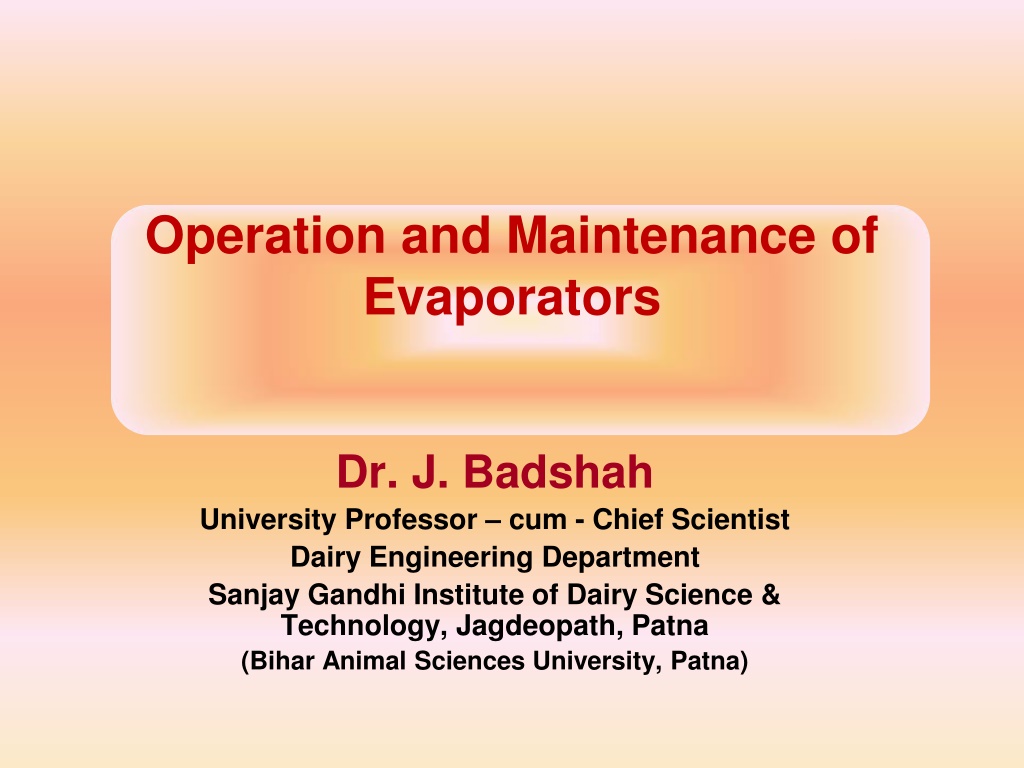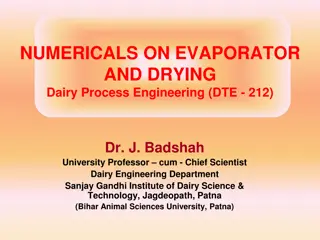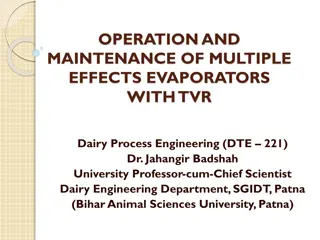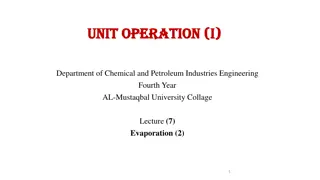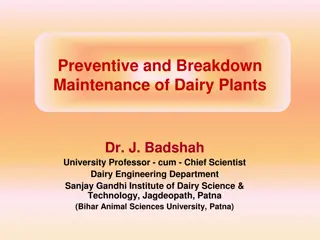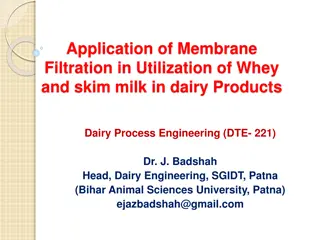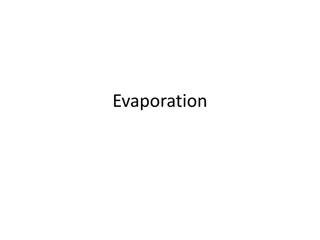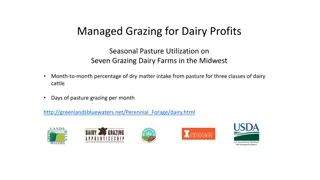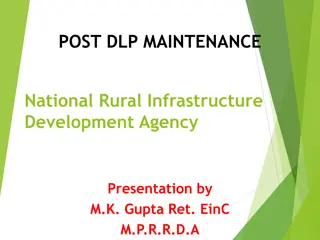Efficient Operation and Maintenance of Evaporators in Dairy Industry
Learn about the operation and maintenance of evaporators in the dairy industry from Dr. J. Badshah's expertise. Discover key steps like preparation, leakage testing, energy-saving designs, and care tips for optimal performance. Understand factors affecting operations and design to enhance efficiency.
Download Presentation

Please find below an Image/Link to download the presentation.
The content on the website is provided AS IS for your information and personal use only. It may not be sold, licensed, or shared on other websites without obtaining consent from the author. Download presentation by click this link. If you encounter any issues during the download, it is possible that the publisher has removed the file from their server.
E N D
Presentation Transcript
Operation and Maintenance of Evaporators Dr. J. Badshah University Professor cum - Chief Scientist Dairy Engineering Department Sanjay Gandhi Institute of Dairy Science & Technology, Jagdeopath, Patna (Bihar Animal Sciences University, Patna)
Operations of evaporators Preparation steps Leakage test steps Circulation of seal water, condenser water, running of liquid ring vacuum pump and spray pond pumps etc. Water in Balance Tank and running on water with adjustment of steam in TC and setting of recirculation line to check circulation of water in vapour separator Setting of proper temperatures in all effects and finally shifting on milk Recirculation and finally adjusting the flow by checking concentration with Baume meter
Energy Saving In Evaporators Evaporator design steam requirement per kg water evaporated and condenser water requirementare*: S. No. Types of evaporator Kg of steam/kg water evaporated 1.17 Kg of water per kg vapour to condense 20 1. Single effect 2. Single effect +TC 057 9 3. Double effect 0.57 9 4. Double effect+TC 0.37 7 6. Triple Effect 0.4 9 7. Triple Effect +TC 0.25 7 8. Six effects 0.08 - 9. 1-effect +MVR 0.012 Kwh - *http://ecoursesonline.iasri.res.in/
Care and maintenance of evaporators Follow the preventive maintenance norms from the manufacturer guidelines. Check the air leaks which may develop around valves, joints, cover and observation posts, as it fluctuates the operating vacuum and temperature. All gaskets must be changed periodically. Avoid the use of high pressure steam. Economy of cooling water to the water cooled condenser should be checked. Keep about 3 C temperature difference between condenser discharge water and cooling water for better economy. Ensure heating surfaces are clean and free from deposits. Class ppt 2
Care and Maintenance contd. Scaling of heat transfer surfaces constitutes a problem and it should be cleaned after an optimum operation time. Descale the plant at least once a year with a suitable acid solution. Check water vacuum system (working of vacuum pumps). Periodical detection of steam coil leakage by hydraulic pressure test. Condensate must be removed properly from the heating surface. Release vacuum immediately in case of sudden power failure. Also steam valves and cooling water supply must be shut off at once.
Factors Affecting Operations & Design One of the important parameter is the overall heat transfer coefficient expressed in W/m2.K. The U-value or the overall heat transfer coefficient is affected by number of factors, such as flow velocity, thermal conductivity of metal and the scale and the turbulence of the liquid product flowing down the tube. The change in specific gravity with change in concentration also affects the U- value. Thus the U-value is much higher for the first effect but goes on decreasing with increased concentration of liquid flowing in subsequent effects. The surface tension and viscosity indirectly affects the flowing velocity and thickness of film causing reduced heat transfer rate. The fouling of milk contact surface with hard scale is the main cause of reduction in U-value with time. The scale formation is basically due to inverse solubility of calcium and phosphorus salts present in milk at the tube wall temperature and protein denaturation at temperature above 70 C occurring at heat transfer wall. In addition to this low flow rate or inadequate wetting of tube wall causes burning of the thin film at the tube wall even at slightly low temperature. Therefore, care is required in the operation of the plant to avoid conditions for hard and tough scale formation in the evaporator calandria. Over hard scale deposit, softer deposits are also formed causing reduction in heat transfer rate. Class ppt 3
Factors Affecting operation and Design With the increase in number of effects the available temperature difference will decrease and hence the capacity will remain constant or may even decrease because of increased loss of heat from surface of calandria. The other factors which affect the plant operation are live steam pressure, flow rate of product, even distribution of feed to all tubes, maintaining constant vacuum, preventing leakage of air and operation of condenser for rapid condensing and removal of condensate. If thermo-compressor is used, the working of plant is affected by variation of steam pressure at inlet to thermo compressor.
Design factors contd. The uniform distribution of product to all the tubes is another major problem in the design and operation of falling film evaporator. The term wetting rate indicates the relationship between product feed rate and heating surface. Every tube requires a certain minimum quantity of product to cover the entire surface. Therefore in a single pass evaporator, the number of tubes per calandria will decrease from effect to effect, because the milk volume is constantly reduced as the concentration is increased. TVR / MVR Steam Jet Ejectors/ Vacuum Pump Water seal to Feed and Concentrate Pump NRV (Non Return Valve at the exit of condensate and concentrate) Condensate removal Pump NCg lines and Vacuum Pumps Spray Pond and Barometric Leg Condenser/ Low head condenser Pumps Leakage Tests Class PPt
